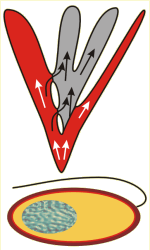 Prokaryotes
Prokaryotes
Prokaryotes are simple, unicellular organisms without cell nuclei or cell organelles.
The figure gives the structure of a typical prokaryotic cell. The cell is separated from its environment by a plasma membrane and a more or less complex cell wall. It is able to move due to one or more flagellae. The DNA of the cell is located in a specific region, but is not separated from the cytoplasm as in the case of a cell nucleus.
The analysis of central gene sequences (like genes involved in the production of proteins) showed that prokaryotes consist of two large groups of organisms, which have developed separately for a very long time, bacteria and archaeae). The eukaryotes, which are the third large group of life, have evolved from endosymbioses between various prokaryotes.